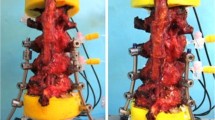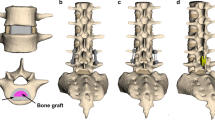Abstract
Purpose
Numerous posterior non-fusion systems have been developed within the past decade to resolve the disadvantages of rigid instrumentations and preserve spinal motion. The aim of this study was to investigate the effect of a new dynamic stabilization device, to measure the screw anchorage after flexibility testing and compare it with data reported in the literature.
Methods
Six human lumbar spine motion segments (L2–5) were loaded in a spine tester with pure moments of 7.5 Nm in lateral bending, flexion/extension and axial rotation. Specimens were tested intact, after instrumentation of the intact segment, after destabilization by a nucleotomy and after instrumentation of the destabilised segment with the new non-fusion device (Elaspine). After flexibility testing all screws were subjected to a pull-out test.
Results
Instrumentation of the intact segment significantly reduced the RoM (p < 0.002) in flexion, extension and lateral bending to 49.7, 44.6 and 53% of the intact state, respectively. In axial rotation, the instrumentation resulted in a non-significant RoM reduction to 95% of the intact state. Compared to the intact segment, instrumentation of the destabilized segment significantly (p < 0.05) reduced the RoM to 69.8, 62.3 and 79.1% in flexion, extension and lateral bending, respectively. In axial rotation, the instrumented segment showed a significantly higher RoM than the intact segment (137.6% of the intact state (p < 0.01)). The pull-out test showed a maximum pull-out force of 855.1 N (±334) with a displacement of 6.1 mm (±2.8) at maximum pull-out force.
Conclusions
The effect of the investigated motion preservation device on the RoM of treated segments is in the range of other devices reported in the literature. Compared to the most implanted and investigated device, the Dynesys, the Elaspine has a less pronounced motion restricting effect in lateral bending and flexion/extension, while being less effective in limiting axial rotation. The pull-out force of the pedicle screws demonstrated anchorage comparable to other screw designs reported in the literature.





Similar content being viewed by others
References
Andersson GB (1999) Epidemiological features of chronic low-back pain. Lancet 354(9178):581–585
Fritzell P, Hagg O, Wessberg P, Nordwall A (2001) Volvo Award Winner in Clinical Studies: Lumbar fusion versus nonsurgical treatment for chronic low back pain: a multicenter randomized controlled trial from the Swedish Lumbar Spine Study Group. Spine (Phila Pa 1976) 26 (23):2521–2532; discussion 2532–2524
Gibson JN, Waddell G (2005) Surgery for degenerative lumbar spondylosis: updated Cochrane Review. Spine (Phila Pa 1976) 30 (20):2312–2320
Disch AC, Schmoelz W, Matziolis G, Schneider SV, Knop C, Putzier M (2008) Higher risk of adjacent segment degeneration after floating fusions: long-term outcome after low lumbar spine fusions. J Spinal Disord Tech 21(2):79–85
Hilibrand AS, Robbins M (2004) Adjacent segment degeneration and adjacent segment disease: the consequences of spinal fusion? Spine J 4(6 Suppl):190S–194S
Khoueir P, Kim KA, Wang MY (2007) Classification of posterior dynamic stabilization devices. Neurosurg Focus 22(1):E3
Gedet P, Haschtmann D, Thistlethwaite PA, Ferguson SJ (2009) Comparative biomechanical investigation of a modular dynamic lumbar stabilization system and the Dynesys system. Eur Spine J 18(10):1504–1511
Schmoelz W, Huber JF, Nydegger T, Dipl I, Claes L, Wilke HJ (2003) Dynamic stabilization of the lumbar spine and its effects on adjacent segments: an in vitro experiment. J Spinal Disord Tech 16(4):418–423
Knop C, Lange U, Bastian L, Blauth M (2000) Three-dimensional motion analysis with Synex. Comparative biomechanical test series with a new vertebral body replacement for the thoracolumbar spine. Eur Spine J 9(6):472–485
Panjabi MM (1988) Biomechanical evaluation of spinal fixation devices: I. A conceptual framework. Spine 13(10):1129–1134
Wilke HJ, Wenger K, Claes L (1998) Testing criteria for spinal implants: recommendations for the standardization of in vitro stability testing of spinal implants. Eur Spine J 7(2):148–154
Wilke HJ, Heuer F, Schmidt H (2009) Prospective design delineation and subsequent in vitro evaluation of a new posterior dynamic stabilization system. Spine (Phila Pa 1976) 34 (3):255–261
Schmoelz W, Onder U, Martin A, von Strempel A (2009) Non-fusion instrumentation of the lumbar spine with a hinged pedicle screw rod system: an in vitro experiment. Eur Spine J 18(10):1478–1485
Schilling C, Kruger S, Grupp TM, Duda GN, Blomer W, Rohlmann A (2010) The effect of design parameters of dynamic pedicle screw systems on kinematics and load bearing: an in vitro study. Eur Spine J 20:297–307
Bozkus H, Senoglu M, Baek S, Sawa AG, Ozer AF, Sonntag VK, Crawford NR (2010) Dynamic lumbar pedicle screw-rod stabilization: in vitro biomechanical comparison with standard rigid pedicle screw-rod stabilization. J Neurosurg Spine 12(2):183–189
Niosi CA, Zhu QA, Wilson DC, Keynan O, Wilson DR, Oxland TR (2006) Biomechanical characterization of the three-dimensional kinematic behaviour of the Dynesys dynamic stabilization system: an in vitro study. Eur Spine J 15(6):913–922
Panjabi MM, Henderson G, James Y, Timm JP (2007) StabilimaxNZ) versus simulated fusion: evaluation of adjacent-level effects. Eur Spine J 16(12):2159–2165
Schulte TL, Hurschler C, Haversath M, Liljenqvist U, Bullmann V, Filler TJ, Osada N, Fallenberg EM, Hackenberg L (2008) The effect of dynamic, semi-rigid implants on the range of motion of lumbar motion segments after decompression. Eur Spine J 17(8):1057–1065
Cunningham BW, Dawson JM, Hu N, Kim SW, McAfee PC, Griffith SL (2010) Preclinical evaluation of the Dynesys posterior spinal stabilization system: a nonhuman primate model. Spine J 10(9):775–783
Ko CC, Tsai HW, Huang WC, Wu JC, Chen YC, Shih YH, Chen HC, Wu CL, Cheng H (2010) Screw loosening in the Dynesys stabilization system: radiographic evidence and effect on outcomes. Neurosurg Focus 28(6):E10
Ianuzzi A, Kurtz SM, Kane W, Shah P, Siskey R, van Ooij A, Bindal R, Ross R, Lanman T, Buttner-Janz K, Isaza J (2010) In vivo deformation, surface damage, and biostability of retrieved Dynesys systems. Spine (Phila Pa 1976) 35 (23):E1310–E1316
Liu CL, Zhong ZC, Shih SL, Hung C, Lee YE, Chen CS (2010) Influence of Dynesys system screw profile on adjacent segment and screw. J Spinal Disord Tech 23(6):410–417
Meyers K, Tauber M, Sudin Y, Fleischer S, Arnin U, Girardi F, Wright T (2008) Use of instrumented pedicle screws to evaluate load sharing in posterior dynamic stabilization systems. Spine J 8(6):926–932
Bozkus H, Senoglu M, Baek S, Sawa AG, Ozer AF, Sonntag VK, Crawford NR (2010) Dynamic lumbar pedicle screw-rod stabilization: in vitro biomechanical comparison with standard rigid pedicle screw-rod stabilization. J Neurosurg Spine 12 (2):183–189
Scifert JL, Sairyo K, Goel VK, Grobler LJ, Grosland NM, Spratt KF, Chesmel KD (1999) Stability analysis of an enhanced load sharing posterior fixation device and its equivalent conventional device in a calf spine model. Spine (Phila Pa 1976) 24 (21):2206–2213
Bullmann V, Schmoelz W, Richter M, Grathwohl C, Schulte TL (2010) Revision of cannulated and perforated cement-augmented pedicle screws: a biomechanical study in human cadavers. Spine (Phila Pa 1976) 35:E932–E939
Masaki T, Sasao Y, Miura T, Torii Y, Kojima A, Aoki H, Beppu M (2009) An experimental study on initial fixation strength in transpedicular screwing augmented with calcium phosphate cement. Spine (Phila Pa 1976) 34 (20):E724–E728
Acknowledgments
The study was supported by institutional funds of Spinelab AG, Winterthur, Switzerland. None of the authors received personal funding.
Conflict of interest
None.
Author information
Authors and Affiliations
Corresponding author
Rights and permissions
About this article
Cite this article
Schmoelz, W., Erhart, S., Unger, S. et al. Biomechanical evaluation of a posterior non-fusion instrumentation of the lumbar spine. Eur Spine J 21, 939–945 (2012). https://doi.org/10.1007/s00586-011-2121-y
Received:
Revised:
Accepted:
Published:
Issue Date:
DOI: https://doi.org/10.1007/s00586-011-2121-y




